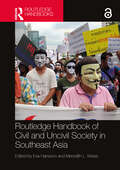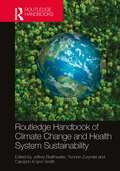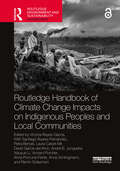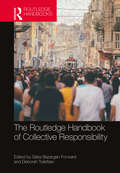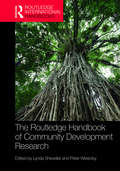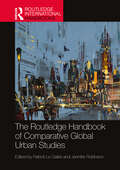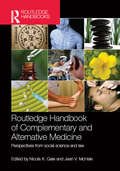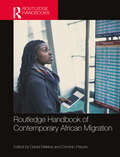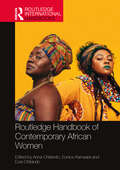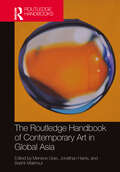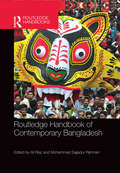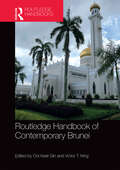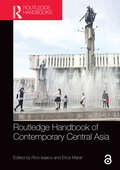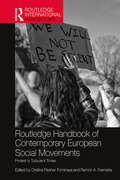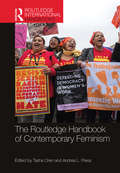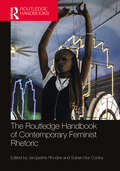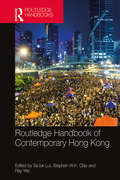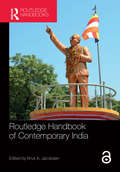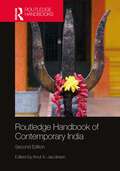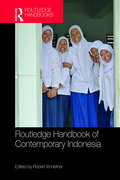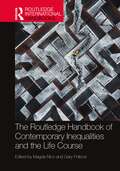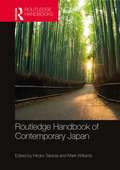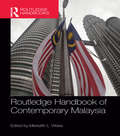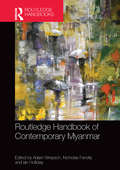- Table View
- List View
Routledge Handbook of Civil and Uncivil Society in Southeast Asia
by Eva Hansson Meredith L. WeissThe Routledge Handbook of Civil and Uncivil Society in Southeast Asia explores the nature and implications of civil society across the region, engaging systematically with both theoretical approaches and empirical nuance for a systematic, comparative, and informative approach. The handbook actively analyses the varying definitions of civil society, critiquing the inconsistent scrutiny of this sphere over time. It brings forth the need to reconsider civil society development in today’s Southeast Asia, including activist organisations' and platforms' composition, claims, resources, and potential to effect sociopolitical change. Structured in five parts, the volume includes chapters written by an international set of experts analysing topics relating to civil society: Spaces and platforms Place within politics Resources and tactics Identity formation and claims Advocacy The handbook highlights the importance of civil society as a domain for political engagement outside the state and parties, across Southeast Asia, as well as the prevalence and weight of 'uncivil' dimensions. It offers a well-informed and comprehensive analysis of the topic and is an indispensable reference work for students and researchers in the fields of Asian Studies, Asian Politics, Southeast Asian Politics and Comparative Politics.
Routledge Handbook of Climate Change and Health System Sustainability
by Jeffrey Braithwaite Yvonne Zurynski Carolynn K-lynn SmithThe Routledge Handbook on Climate Change and Health System Sustainability takes the reader on a journey to understand the interconnectedness of human health, climate change, and healthcare systems.The book begins by exploring how climate change is affecting human health through the increasing frequency of natural disasters, such as bush fires, droughts and heatwaves, and the emergence of new infectious diseases, such as the SARS-CoV2 virus, all of which drive up demand for health services that are already heavily burdened by increasing rates of chronic diseases and ageing populations. Chapters then turn to the contribution of the healthcare system itself to climate change— explaining how current clinical practices, including wasteful care of low value, create an unsustainable carbon footprint and threaten the very viability of healthcare systems. Throughout the volume, descriptions of practical solutions and implemented case studies are used to illustrate the feasibility of taking action in the real world of the healthcare delivery ecosystem.Bringing together a mix of forward-thinking environmental and health researchers, policymakers, leaders, managers, clinicians, patients, and health industry leaders to clarify the current state and future of sustainable healthcare systems, this book will be of interest to researchers and policymakers of climate and health systems.
Routledge Handbook of Climate Change Impacts on Indigenous Peoples and Local Communities (Routledge Environment and Sustainability Handbooks)
by Victoria Reyes-GarcíaThis Handbook examines the diverse ways in which climate change impacts Indigenous Peoples and local communities and considers their response to these changes. While there is well-established evidence that the climate of the Earth is changing, the scarcity of instrumental data oftentimes challenges scientists’ ability to detect such impacts in remote and marginalized areas of the world or in areas with scarce data. Bridging this gap, this Handbook draws on field research among Indigenous Peoples and local communities distributed across different climatic zones and relying on different livelihood activities, to analyse their reports of and responses to climate change impacts. It includes contributions from a range of authors from different nationalities, disciplinary backgrounds, and positionalities, thus reflecting the diversity of approaches in the field. The Handbook is organised in two parts: Part I examines the diverse ways in which climate change – alone or in interaction with other drivers of environmental change – affects Indigenous Peoples and local communities; Part II examines how Indigenous Peoples and local communities are locally adapting their responses to these impacts. Overall, this book highlights Indigenous and local knowledge systems as an untapped resource which will be vital in deepening our understanding of the effects of climate change. The Routledge Handbook of Climate Change Impacts on Indigenous Peoples and Local Communities will be an essential reference text for students and scholars of climate change, anthropology, environmental studies, ethnobiology, and Indigenous studies.
Routledge Handbook of Climate Change Impacts on Indigenous Peoples and Local Communities (Routledge Environment and Sustainability Handbooks)
by Victoria Reyes-GarcíaThis Handbook examines the diverse ways in which climate change impacts Indigenous Peoples and local communities and considers their response to these changes.While there is well-established evidence that the climate of the Earth is changing, the scarcity of instrumental data oftentimes challenges scientists’ ability to detect such impacts in remote and marginalized areas of the world or in areas with scarce data. Bridging this gap, this Handbook draws on field research among Indigenous Peoples and local communities distributed across different climatic zones and relying on different livelihood activities, to analyse their reports of and responses to climate change impacts. It includes contributions from a range of authors from different nationalities, disciplinary backgrounds, and positionalities, thus reflecting the diversity of approaches in the field. The Handbook is organised in two parts: Part I examines the diverse ways in which climate change – alone or in interaction with other drivers of environmental change – affects Indigenous Peoples and local communities; Part II examines how Indigenous Peoples and local communities are locally adapting their responses to these impacts. Overall, this book highlights Indigenous and local knowledge systems as an untapped resource which will be vital in deepening our understanding of the effects of climate change.The Routledge Handbook of Climate Change Impacts on Indigenous Peoples and Local Communities will be an essential reference text for students and scholars of climate change, anthropology, environmental studies, ethnobiology, and Indigenous studies.The Open Access version of this book, available at www.taylorfrancis.com, has been made available under a Creative Commons Attribution-Non Commercial-No Derivatives (CC-BY-NC-ND) 4.0 license.
The Routledge Handbook of Collective Responsibility (Routledge Handbooks in Philosophy)
by Bazargan-Forward, Saba / Tollefsen, DeborahThe Routledge Handbook of Collective Responsibility comprehensively addresses questions about who is responsible and how blame or praise should be attributed when human agents act together. Such questions include: Do individuals share responsibility for the outcome or are individuals responsible only for their contribution to the act? Are individuals responsible for actions done by their group even when they don’t contribute to the outcome? Can a corporation or institution be held morally responsible apart from the responsibility of its members? The Handbook’s 35 chapters—all appearing here for the first time and written by an international team of experts—are organized into four parts:Part I: Foundations of Collective ResponsibilityPart II: Theoretical Issues in Collective ResponsibilityPart III: Domains of Collective ResponsibilityPart IV: Applied Issues in Collective ResponsibilityEach part begins with a short introduction that provides an overview of issues and debates within that area and a brief summary of its chapters. In addition, a comprehensive index allows readers to better navigate the entirety of the volume’s contents. The result is the first major work in the field that serves as an instructional aid for those in advanced undergraduate courses and graduate seminars, as well as a reference for scholars interested in learning more about collective responsibility.
The Routledge Handbook of Community Development Research (Routledge International Handbooks)
by Lynda Shevellar Peter WestobyThis handbook sets a new research agenda in community development. The contributors redefine existing areas within the context of interdisciplinary research, highlight emerging areas for community development related research, and provide researchers and post-graduate students with ideas and encouragement for future research activity. To do this, the editors have deliberately chosen to frame this book not through a traditional sociological lens of class, race and gender, but through a "Wicked Problems" framework. Drawing upon the work of 37 international authors, in diverse settings such as West Papua, Peru, the USA and Australia; and with methodologies equally as diverse, from case studies and interviews to the use of music and story-telling, this handbook focuses upon five Wicked Problems: forced displacement; family, gender and child related violence; indigenous marginalisation; climate change and food security; and human survival in the context of disaster and recovery work. By drawing together leading scholars from community development, social work and social policy, this handbook provides an up to the minute snapshot of current scholarship as well as signposting several fruitful avenues for future research. This book is both an invaluable resource for both scholars and practitioners and an indispensable teaching tool for use in the classroom and in the field.
The Routledge Handbook of Comparative Global Urban Studies (Routledge International Handbooks)
by Patrick Le Galès Jennifer RobinsonThe Routledge Handbook of Comparative Global Urban Studies is a timely intervention into the field of global urban studies, coming as comparison is being more widely used as a method for global urban studies, and as a number of methodological experiments and comparative research projects are being brought to fruition. It consolidates and takes forward an emerging field within urban studies and makes a positive and constructive intervention into a lively arena of current debate in urban theory. Comparative urbanism injects a welcome sense of methodological rigor and a commitment to careful evaluation of claims across different contexts, which will enhance current debates in the field. Drawing together more than 50 international scholars and practitioners, this book offers an overview of key ideas and practices in the field and extends current thinking and practice. The book is primarily intended for scholars and graduate students for whom it will provide an invaluable and up-to-date guide to current thinking across the range of disciplines which converge in the study of urbanism, including geography, sociology, political studies, planning, and urban studies.
Routledge Handbook of Complementary and Alternative Medicine: Perspectives from Social Science and Law
by Jean V. McHale Nicola K. GaleThe provision and use of traditional, complementary and alternative medicine (CAM) has been growing globally over the last 40 years. As CAM develops alongside - and sometimes integrates with - conventional medicine, this handbook provides the first major overview of its regulation and professionalization from social science and legal perspectives. The Routledge Handbook of Complementary and Alternative Medicine draws on historical and international comparative research to provide a rigorous and thematic examination of the field. It argues that many popular and policy debates are stuck in a polarized and largely asocial discourse, and that interdisciplinary social science perspectives, theorising diversity in the field, provide a much more robust evidence base for policy and practice in the field. Divided into four sections, the handbook covers: analytical frameworks power, professions and health spaces risk and regulation perspectives for the future. This important volume will interest social science and legal scholars researching complementary and alternative medicine, professional identify and health care regulation, as well as historians and health policymakers and regulators.
Routledge Handbook of Contemporary African Migration
by Daniel Makina and Dominic PasuraThis handbook provides an authoritative multidisciplinary overview of contemporary African international migration. It endeavours to present a single source of reference on issues such as migration history, trends, migrant profiles, narratives, migration-development nexus, migration governance, diasporas, impact of the COVID-19 pandemic, among others. The handbook assembles a multidisciplinary contributor team of distinguished and upcoming Africanist scholars, practitioners, researchers, and policy experts both inside and outside Africa to contribute their perspectives on contemporary African migration. It attempts to address some of the following pertinent questions: • What drives contemporary migration in Africa? • How are its patterns and trends evolving? • What is the architecture of migration governance in Africa? • How do migration, diaspora engagement and development play out in Africa? • What are the future trajectories of African migration? The handbook is a valuable resource for practitioners, politicians, researchers, university students, and academics interested in studying and understanding contemporary African migration.
Routledge Handbook of Contemporary African Women (Routledge International Handbooks)
by Anna Chitando Eunice Kamaara Ezra ChitandoThe Routledge Handbook of Contemporary African Women highlights the achievements and progress being made by African women across a wide range of sectors in society. Without glossing over the very real challenges which women in Africa continue to face, this landmark handbook demonstrates how women across the continent are deploying their agency to achieve notable progress in areas as diverse as:• Pandemics• Climate Change• Science & Technology• Entrepreneurship• Higher Education• Youth & Older PeopleChallenging prevailing narratives and stereotypes about African women, this handbook provides a more positive perspective into African women’s progressive actions for sustainable development. It will be an essential read for readers across the fields of gender, environment, political science, history, development studies, religious studies and African Studies.
The Routledge Handbook of Contemporary Art in Global Asia
by Menene Gras Jonathan Harris Bashir MakhoulThis substantial collection of newly commissioned essays presents an ambitious, entertaining, and accessible guide to developments in Asian art over the past 20 years of the epoch of globalization. The term ‘global Asia’ signals the genesis and evolution of contemporary art within the context of global economic, social, political, and intellectual change related to the end of the Cold War, decolonization, the emergence of postcolonial societies and cultures, and the rise of a global contemporary art world. In the handbook its editors establish, in an extended introductory section and in four section introductions, the theoretical, geographical, and historical parameters within which the contemporary visual arts of ‘global Asia’ may be described, analyzed, and evaluated. The collected chapters provide a diverse, multiauthored, heterogeneous, and genuinely plural account of art and its contexts. The democratic and inclusive character of globalization is reflected and produced within this anthology, which includes different styles of writing as well as varieties of analytic and thematic focus. The anthology will appeal to both scholars and students in art history, art practice, curation, contemporary art, fine art, cultural studies, and globalization studies.
Routledge Handbook of Contemporary Bangladesh
by Ali Riaz Mohammad Sajjadur RahmanIn the past decade, Bangladesh has achieved significant social and economic progress. Despite high population density, a limited natural-resource base, underdeveloped infrastructure, frequent natural disasters and political uncertainty, the country has recorded positive developments in terms of broad economic and social indicators. This Handbook presents a comprehensive and interdisciplinary resource on the politics, society and economy of Bangladesh today. Divided into six thematic sections, the Handbook focuses on relevant issues and trends on: History and the making of contemporary Bangladesh Politics and institutions Economy and development Energy and environment State, society and rights Security and external relations Written by a team of international experts in the field, the chapters provide an accessible and up-to-date insight into contemporary Bangladesh. The Handbook will be of interest to students and academics of South Asian studies, as well as policymakers, journalists and others who wish to learn more about this increasingly important country.
Routledge Handbook of Contemporary Brunei
by Ooi Keat Gin Victor T. KingThe Routledge Handbook of Contemporary Brunei presents an overview of significant themes, issues, and challenges pertinent to Brunei Darussalam in the twenty-first century. Multidisciplinary in coverage, the contributions cover topics relating to philology, history, religion, language and literature, geography, international relations, economics, politics and sociocultural traditions. The Handbook is structured in eight parts: Foundations History Faith and Ethnicity Literature Language and Education Economics Material Culture Empowerment Chapters focus on the recent past and contemporary developments in this unique country that has remained a Malay Muslim sultanate, sustaining its religious and traditional heritage encapsulated in the national philosophy, Melayu Islam Beraja (MIB, Malay Islamic Monarchy). The MIB represents the sultanate’s three pillars of social, cultural, political and economic sustainability, and the contributors discuss this concept in relation to the notion of ‘Malay’ or ‘Malaydom’, the official religion of the nation-state, Islam and monarchy as the essential system of government. This Handbook is an invaluable reference work for students of Asian and Southeast Asian Studies and researchers interested in the smallest Association of Southeast Asian Nations (ASEAN) state.
Routledge Handbook of Contemporary Central Asia
by Rico Isaacs and Erica MaratThe Routledge Handbook of Contemporary Central Asia offers the first comprehensive, cross-disciplinary overview of key issues in Central Asian studies. The 30 chapters by leading and emerging scholars summarise major findings in the field and highlight long-term trends, recent observations and future developments in the region. The handbook features case studies of all five Central Asian republics and is organised thematically in seven sections: • History • Politics • Geography • International Relations • Political Economy • Society and Culture • Religion An essential cross-disciplinary reference work, the handbook offers an accessible and easyto- understand guide to the core issues permeating the region to enable readers to grasp the fundamental challenges, transformations and themes in contemporary Central Asia. It will be of interest to researchers, academics and students of the region and those working in the field of Area Studies, History, Anthropology, Politics and International Relations.
Routledge Handbook of Contemporary European Social Movements: Protest in Turbulent Times (Routledge International Handbooks)
by Cristina Flesher Fominaya Ramón A. FeenstraEuropean social movements have become increasingly visible in recent years, generating intense public debates. From anti-austerity and pro-democracy movements to right-wing nationalist movements, these movements expose core conflicts around European democracy, identity, politics and society. The Routledge Handbook of Contemporary European Social Movements offers a comprehensive interdisciplinary overview of the analysis of European social movements, helping to orient scholars and students navigating a rapidly evolving field while developing a new agenda for research in the area. The book is divided into eight sections: Visions of Europe; Contemporary models of democracy; Historical evolution of major European movements; Feminism and sexualities; Movement diffusion within and beyond Europe; Anti-austerity movements; Technopolitical and media movements; and Movements, parties and movement-parties. Key theories and empirical trajectories of core movements, their central issues, debates and impacts are covered, with a focus on how these have influenced and been influenced by their European context. Democracy, and how social movements understand it, renew it, or undermine it, forms a core thread that runs through the book. Written in a clear and direct style, the Handbook provides a key resource for students and scholars hoping to understand the key debates and innovations unfolding in the heart of European social movements and how these affect broader debates on such areas as democracy, human rights, the right to the city, feminism, neoliberalism, nationalism, migration and European values, identity and politics. Extensive references and sources will direct readers to areas of further study.
The Routledge Handbook of Contemporary Feminism (Routledge International Handbooks)
by Tasha Oren Andrea PressFeminism as a method, a movement, a critique, and an identity has been the subject of debates, contestations and revisions in recent years, yet contemporary global developments and political upheavals have again refocused feminism’s collective force. What is feminism now? How do scholars and activists employ contemporary feminism? What feminist traditions endure? Which are no longer relevant in addressing contemporary global conditions? In this interdisciplinary collection, scholars reflect on how contemporary feminism has shaped their thinking and their field as they interrogate its uses, limits, and reinventions. Organized as a set of questions over definition, everyday life, critical intervention, and political activism, the Handbook takes on a broad set of issues and points of view to consider what feminism is today and what current forces shape its future development. It also includes an extended conversation among major feminist thinkers about the future of feminist scholarship and activism. The scholars gathered here address a wide variety of topics and contexts: activism from post-Soviet collectives to the Arab spring, to the #MeToo movement, sexual harassment, feminist art, film and digital culture, education, technology, policy, sexual practices and gender identity. Indispensable for scholars undergraduate and postgraduate students in women, gender, and sexuality, the collection offers a multidimensional picture of the diversity and utility of feminist thought in an age of multiple uncertainties.
The Routledge Handbook of Contemporary Feminist Rhetoric (Routledge Handbooks in Communication Studies)
by Jacqueline Rhodes Suban Nur CooleyThe Routledge Handbook of Contemporary Feminist Rhetoric explores the histories, concerns, and possible futures of feminist rhetorical work in the late 20th and early 21st centuries.Featuring work from scholars across disciplines, this book explores where we have been, where we are, and where we might be going. Forwarding key areas of study in feminist rhetoric, the handbook is divided into five interrelated sections—Time: Discovering, Recovering, and Composing our Histories; Space: Setting and Testing Boundaries: Physical and Digital Locales; Movement: Exploring Activism, Migration, and Globalism; Being: Celebrating (and Insisting on) Embodied Praxis; and Becoming: Transforming Hopes into Feminist Practice. Throughout the handbook, contributors survey and document the critical work of feminist rhetoric, pointing to ongoing interests in history, politics, and activism while showcasing new lines of inquiry and new methods of analysis, critique, and intervention.The first of its kind, this accessibly written handbook will be an indispensable resource for scholars and researchers in the fields of rhetoric, writing studies, communication studies, and women’s and gender studies.
Routledge Handbook of Contemporary Hong Kong
by Tai-Lok Lui Stephen W.K. Chiu Ray YepWhen Britain and China negotiated the future of Hong Kong in the early 1980s, their primary concern was about maintaining the status quo. The rise of China in the last thirty years, however, has reshaped the Beijing-Hong Kong dynamic as new tensions and divisions have emerged. Thus, post-1997 Hong Kong is a case about a global city’s democratic transition within an authoritarian state. The Routledge Handbook of Contemporary Hong Kong introduces readers to these key social, economic, and political developments. Bringing together the work of leading researchers in the field, it focuses on the process of transition from a British colony to a Special Administrative Region under China’s sovereign rule. Organized thematically, the sections covered include: ‘One Country, Two Systems’ in practice Governance in post-colonial Hong Kong Social mobilization The changing social fabric of Hong Kong society Socio-economic development and regional integration The future of Hong Kong. This book provides a thorough introduction to Hong Kong today. As such, it will be invaluable to students and scholars of Hong Kong’s politics, culture and society. It will also be of interest to those studying Chinese political development and the impact of China’s rise more generally.
Routledge Handbook of Contemporary India
by Knut A. JacobsenIndia is the second largest country in the world with regard to population, the world’s largest democracy and by far the largest country in South Asia, and one of the most diverse and pluralistic nations in the world in terms of official languages, cultures, religions and social identities. Indians have for centuries exchanged ideas with other cultures globally and some traditions have been transformed in those transnational and transcultural encounters and become successful innovations with an extraordinary global popularity. India is an emerging global power in terms of economy, but in spite of India’s impressive economic growth over the last decades, some of the most serious problems of Indian society such as poverty, repression of women, inequality both in terms of living conditions and of opportunities such as access to education, employment, and the economic resources of the state persist and do not seem to go away. This Handbook contains chapters by the field’s foremost scholars dealing with fundamental issues in India’s current cultural and social transformation and concentrates on India as it emerged after the economic reforms and the new economic policy of the 1980s and 1990s and as it develops in the twenty-first century. Following an introduction by the editor, the book is divided into five parts: Part I: Foundation Part II: India and the world Part III: Society, class, caste and gender Part IV: Religion and diversity Part V: Cultural change and innovations Exploring the cultural changes and innovations relating a number of contexts in contemporary India, this Handbook is essential reading for students and scholars interested in Indian and South Asian culture, politics and society.
Routledge Handbook of Contemporary India
by Knut A. JacobsenThis revised and updated new edition of the Routledge Handbook of Contemporary India concentrates on India as it emerged after the economic reforms and the new economic policy of the 1980s and 1990s and as it develops in the twenty-first century. It presents new developments and advancements in the research literature and includes discussions of the major political change in India since the Hindu nationalist party Bharatiya Janata Party (BJP) came to power in 2014. This Handbook contains chapters by the field’s foremost scholars dealing with fundamental issues in India’s current cultural and social transformation. This new edition also contains six new chapters on topics not covered by the first edition, such as changes caused by the Hindu majoritarian political ideology, the Hinduization process in the northeast of India and contemporary Dalit and Adivasi literatures. Following an introduction by the editor, the book is divided into five parts: Part I: Foundation Part II: India and the world Part III: Society, class, caste and gender Part IV: Religion and diversity Part V: Cultural change and innovations Exploring the cultural changes and innovations relating a number of contexts in contemporary India, this Handbook is essential reading for students and scholars interested in Indian and South Asian culture, politics and society.
Routledge Handbook of Contemporary Indonesia
by Robert W. HefnerFew countries as culturally rich, politically pivotal, and naturally beautiful as Indonesia are as often misrepresented in global media and conversation. Stretching 3,400 miles east to west along the equator, Indonesia is the fourth most populous country in the world and home to more than four hundred ethnic groups and several major world religions. This sprawling Southeast Asian nation is also the world’s most populous Muslim-majority country and the third largest democracy. Although in recent years the country has experienced serious challenges with regard to religious harmony, its trillion-dollar economy is booming and its press and public sphere are among the most vibrant in Asia. A land of cultural contrasts, contests, and contradictions, this ever-evolving country is today rising to even greater global prominence, even as it redefines the terms of its national, religious, and civic identity. The Routledge Handbook of Contemporary Indonesia offers an overview of the modern making and contemporary dynamics of culture, society, and politics in this powerful Asian nation. It provides a comprehensive survey of key issues in Indonesian politics, economics, religion, and society. It is divided into six sections, organized as follows: Cultural Legacies and Political Junctures Contemporary Politics and Plurality Markets and Economic Cultures Muslims and Religious Plurality Gender and Sexuality Indonesia in an Age of Multiple Globalizations Bringing together original contributions by leading scholars of Indonesia in law, political science, history, anthropology, sociology, religious studies, and gender studies this Handbook provides an up-to-date, interdisciplinary, and academically rigorous exploration of Indonesia. It will be of interest to students, academics, policymakers, and others in search of reliable information on Indonesian politics, economics, religion, and society in an accessible format.
The Routledge Handbook of Contemporary Inequalities and the Life Course (Routledge International Handbooks)
by Magda NicoDrawing upon perspectives from across the globe and employing an interdisciplinary life course approach, this handbook explores the production and reproduction of different types of inequality across a variety of social contexts. Inequalities are not static, easily measurable, and essentially quantifiable circumstances of life. They are processes which impact on individuals throughout the life course, interacting with each other, accumulating, attenuating, reproducing, or distorting themselves along the way. The chapters in this handbook examine various types of inequality, such as economic, gender, racial, and ethnic inequalities, and analyse how these inequalities manifest themselves within different aspects of society, including health, education, and the family, at multiple levels and dimensions. The handbook also tackles the global COVID-19 pandemic and its striking impact on the production and intensification of inequalities. The interdisciplinary life course approach utilised in this handbook combines quantitative and qualitative methods to bridge the gap between theory and practice and offer strategies and principles for identifying and tackling issues of inequality. This book will be indispensable for students and researchers as well as activists and policy makers interested in understanding and eradicating the processes of production, reproduction, and perpetuation of inequalities.
Routledge Handbook of Contemporary Japan
by Hiroko Takeda; Mark WilliamsThe Routledge Handbook of Contemporary Japan presents a synthesized, interdisciplinary study of contemporary Japan based on up-to-date theoretical models designed to provide readers with a comprehensive and full understanding of the dynamics of contemporary Japan. In order to achieve this, the Handbook is organized into two parts. Part I, ‘Foundations’, clarifies the state of contemporary Japan topic by topic by referring to the latest theoretical developments in the relevant disciplinary fields of politics, international relations, economy, society, culture and the personal. Part II, ‘Issues’, then offers a series of concrete analyses building upon the theoretical discussions introduced in Part I to help undergraduate and postgraduate students learn how to conduct independent analysis. Locating Japan in a comparative and interdisciplinary perspective, this Handbook is an essential resource for students and scholars interested in Japanese studies, Asian studies and global studies.
Routledge Handbook of Contemporary Malaysia
by Meredith L. WeissThe Routledge Handbook of Contemporary Malaysia offers a broad, analytical survey of Malaysia. It provides a comprehensive survey of significant topics in Malaysian politics, economy, and society today, focussing on issues, institutions, and trends. It is divided into four thematic sections, which are all introduced by the editor: • Domestic politics • Economics • Social policy and social development • International relations and security. The volume brings together an international team of experts: an interdisciplinary mix of forty contributors from Malaysia and elsewhere, including many of the leading specialists on Malaysian affairs. The chapters included in the volume form an accessible and fascinating window onto contemporary Malaysia. They each introduce a different aspect of the Malaysian polity, economy, or society, offering both historical perspective and a current assessment or investigation. Designed for general readers and specialists alike, chapters may be read individually -- each stands on its own -- or conjointly. Up-to-date, interdisciplinary, and academically rigorous, the Handbook will be of interest to students, academics, policymakers, and others in search of reliable information on Malaysian politics, economics, and society.
Routledge Handbook of Contemporary Myanmar
by Adam Simpson , Nicholas Farrelly and Ian HollidayAfter decades of mismanagement and direct military rule, Myanmar’s contested transition to a more democratic government has rapidly shifted the outlook in this significant Southeast Asian nation. Since 2011, the removal of Western sanctions and new foreign investments have resulted in high rates of economic growth and an expanding middle class, albeit from a very low base. In a result unthinkable a few years earlier, former political prisoner and Nobel laureate Aung San Suu Kyi and her party, the National League for Democracy (NLD), formed a national government in early 2016. However, despite significant political and economic reforms since the liberalisation process commenced, the transition to civilian rule remains constrained by the military’s 2008 Constitution, which guarantees that it operates unfettered by civilian oversight. As a result, although some ethnic conflicts have abated, others continue to fester and new conflicts have erupted. With a daunting task ahead the NLD government has made some progress in removing the vestiges of repressive military-era laws but many remain untouched and some of the practices of the new government provide unwelcome reminders of its authoritarian history. This timely Handbook describes the political, economic, and cultural dimensions of this crucial period of transition in Myanmar. It presents explanations for contradictory trends, including those that defy some of the early narratives about the comprehensive transformation of Myanmar. The Handbook also considers the impact of major environmental, strategic, and demographic trends which help underscore that Myanmar’s development will be an ongoing task. In addition to introductory and concluding chapters by the editors, the body of the Handbook is divided into seven core sections: • Fundamentals • Spaces • Cultures • Living • Governance • International • Challenges Written by an international team of scholars, with a mix of world-leading established academics and talented emerging researchers, the Handbook provides a rigorous scholarly overview of Myanmar’s politics, economics, and society. As Myanmar opens to Western businesses and government agencies, this is an invaluable reference book that will provide a foundation for further research and offer the first port of call for scholars, students, and policy makers working on Myanmar and Asia.
